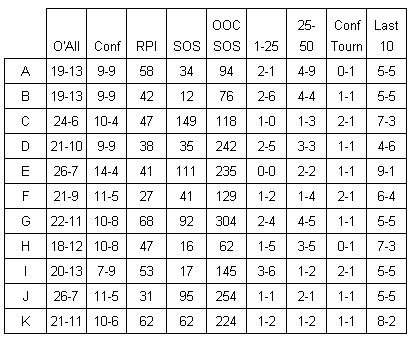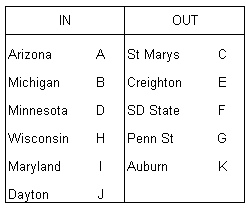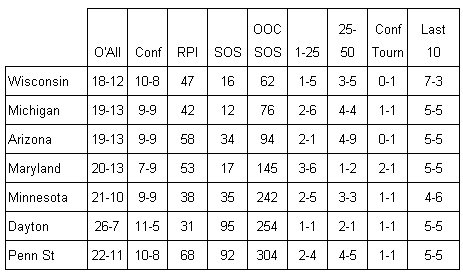Better to remain silent and be thought a fool than to speak out and remove all doubt.
Abraham Lincoln
As I pondered the post-selection thoughts by the ESPN talking heads, I couldn’t help but be reminded of the advice given by our 16th president. Ole Digger seems to have taken this advice to heart, while some others would do well to follow suit.
In reality, it does no good to talk to Dick Vitale or Bobby Knight on Selection Sunday wrt the Bubble Selections. Neither one has any cogent thoughts to share and essentially said the same thing as last year. We have added a new peanut to our gallery of mixed nuts and Doug Gottlieb (where did he come from?) joined Dick Vitale in jumping the shark when discussing mid-majors.
It has become obvious that Dick Vitale will select the most highly-ranked mid-major team and champion their cause…no matter how weak. Gottlieb and Vitale both took the approach that the selection process is not fair to the mid-majors because they don’t have as many chances to play highly ranked teams. (For those that missed the show, St Mary’s was this year’s “wronged†team.)
Bilas made the point that mid-majors have every opportunity in their OOC schedule to play the big boys if they want to. Vitale claimed that the big boys wouldn’t play them. Gottlieb tried to take the approach that St Mary’s tried, but the “big†teams that they had scheduled didn’t turn out to be any good…which wasn’t their fault. Note that Gottlieb lost all credibility when he claimed that Kent St was a “big†team that St Mary’s scheduled.
We’ve discussed the OOC schedule of the ACC teams a number of times over the last several years. The strength of a team’s OOC schedule is a choice…not an accident. Teams that want to play a tough OOC schedule can get one no matter what conference they play in. It is interesting to note that Gonzaga plays in St Mary’s conference and their OOC SOS was ranked 29th in the nation. So does anyone really think that the big boys are afraid to play St Mary’s?
Poor Bobby Knight appeared to be on his meds, but he is just barely hanging on. Last year, he wanted to include every team in the tournament. This year he only pushed for 128 teams. After all, it’s only one more game.
OK, let’s not take any more shots at fish in a barrel and move onto the bubble analysis.
Based on seeding, the last six teams in were Arizona, Michigan, Minnesota, Wisconsin, Maryland, and Dayton. According to the talking heads, the last teams left out were St Mary’s, Creighton, San Diego State, Penn St, and Auburn. Let’s take an objective look at these 11 teams and see what we can discover about this year’s selection process. In no particular order, here are the various stats for our 11 teams. Pick your best six using whatever criteria you think is most appropriate and I’ll reveal the Selection Committee’s decisions down below.

There are a number of ways to slice and dice these various stats. If you picked only one category as the most important, then how would that align with the Selection Committee decisions?
If you pick RPI as the most important, then you would have only picked three of the six teams that made the NCAAT.
If you pick top-50 wins as your category (which would be mine), then you would get 5 of the 6 teams.
If you pick overall SOS, then you would also get 5 of the 6 teams.
If you pick OOC SOS, then you would get 4 of the 6 teams.
If you pick conference tournament performance, then you only have three teams in and two teams out. Of your five selections, four of them would be wrong.
Ready to see which team is which? Scroll down for your answers.
.
.
.
.
.
.
.
.

It is always good to keep your goal in mind when you are working on a problem. The Selection Committee’s first job is to pick the best 34 teams in the country that did not receive an automatic qualification. So how do you decide between St Mary’s and Arizona? The answer seems pretty simple to me…the best teams will prove it by beating other good teams.
I really have no sympathy for any of the teams left out. Four of the five simply didn’t beat enough good teams to warrant their inclusion over the six that were selected. The really interesting team to discuss is Penn State. Let’s refine the table from above and list the various stats for the six teams that got in along with Penn St and see what we can find.

Here are some arguments for including Penn St in the NCAAT.
– They tied for the most wins against the top-50 (6).
– Only one team had more wins against the top-25.
– Two teams included in the NCAAT lost in the first round of their conference tournament (including one from the Big 10).
– Two teams from the Big 10 that were selected (Minn and Mich) had worse conference records and all three had the same results in the conference tournament (1-1).
So why was Penn State left out?
Personally, I believe that the Selection Committee made a conscious decision to penalize Penn St for their OOC schedule. I go back to my old formula which has worked against a number of ACC teams in the past and got Arizona State last year:
Miserable OOC schedule +
Mediocre conference performance +
Mediocre conference tourney performance =
NIT
Just like when we were discussing St Mary’s, your OOC schedule is a choice. Sometimes we have to pay the consequences that come from our bad decisions…unless you get Chairman Obama on your side. While he has offered opinions on college football’s post-season, he hasn’t made any promises about the NCAAT… at least not yet. So schedule whoever you want OOC, but be prepared to do way better than average in your conference schedule and/or conference tournament.



You must be logged in to post a comment.